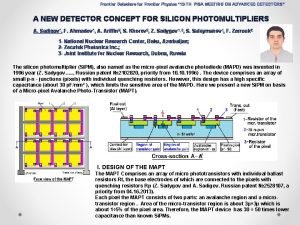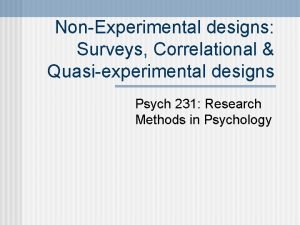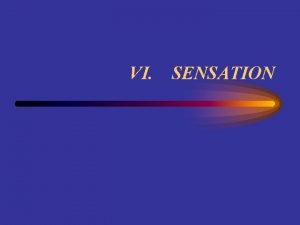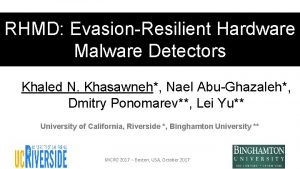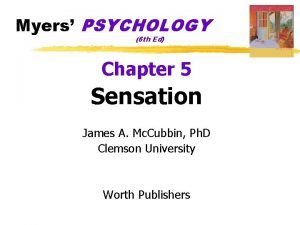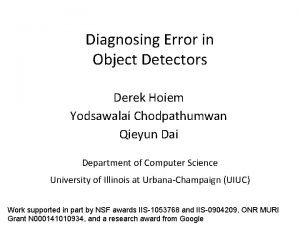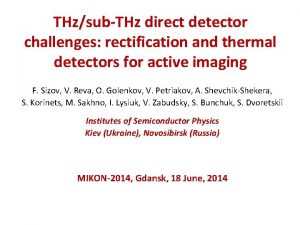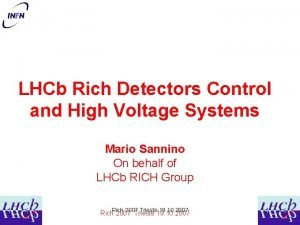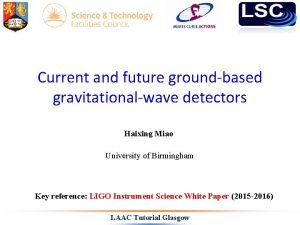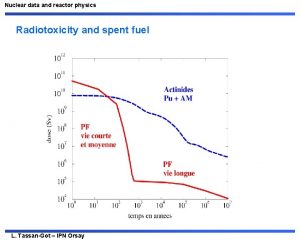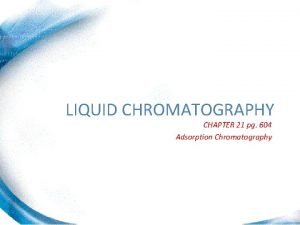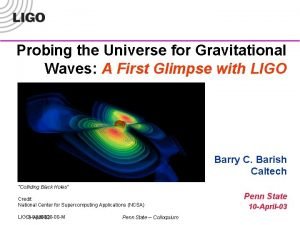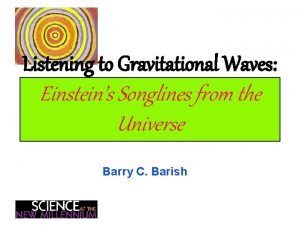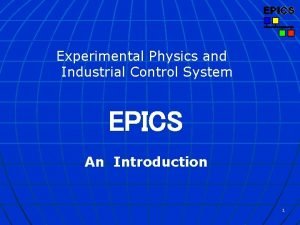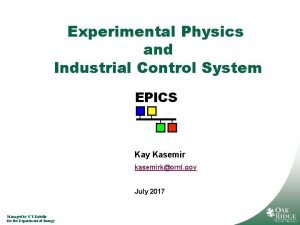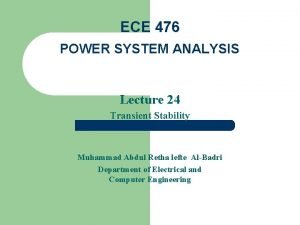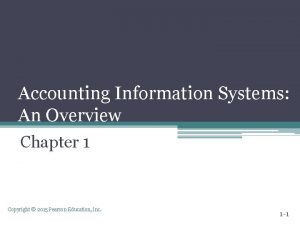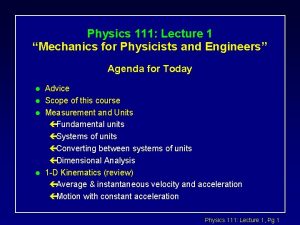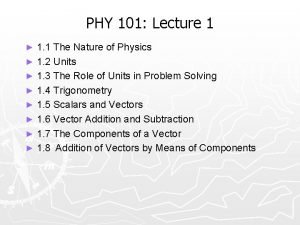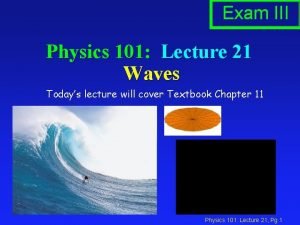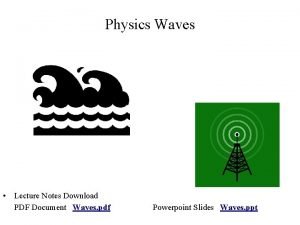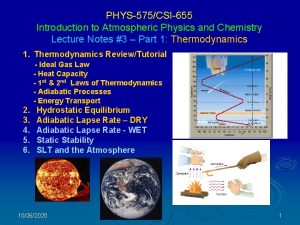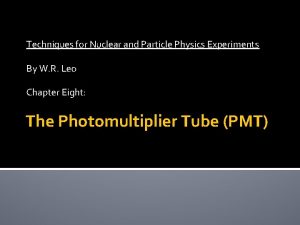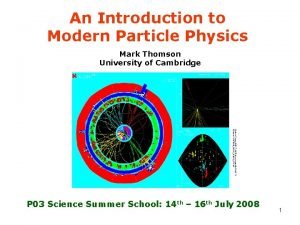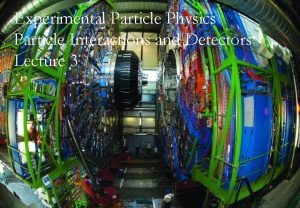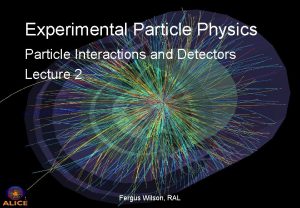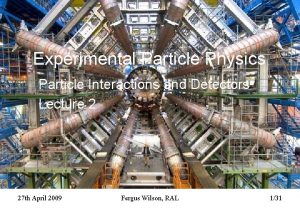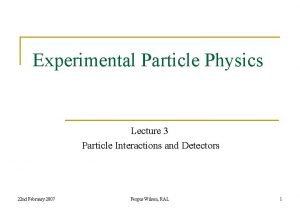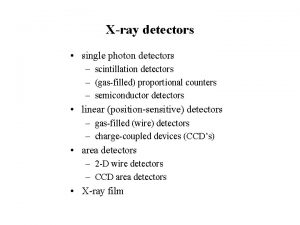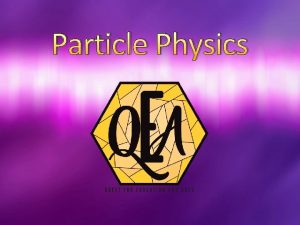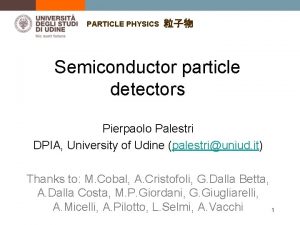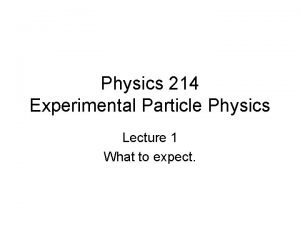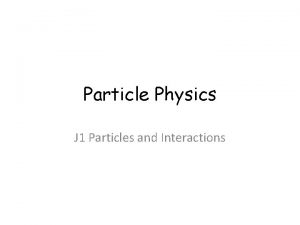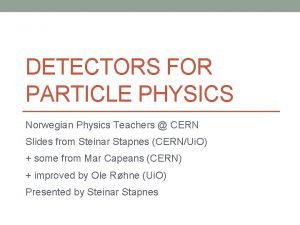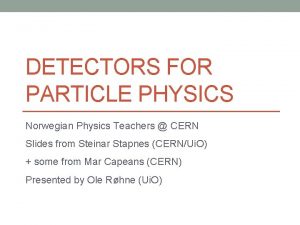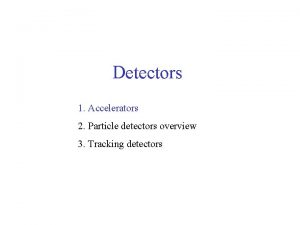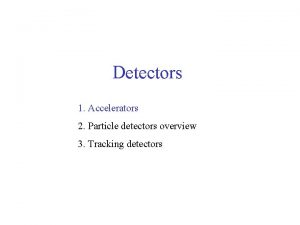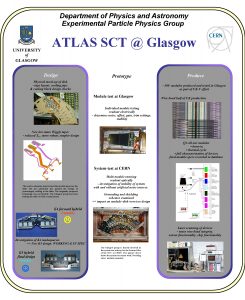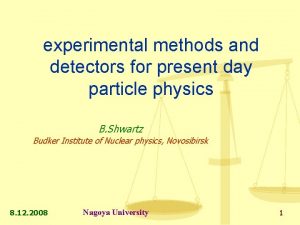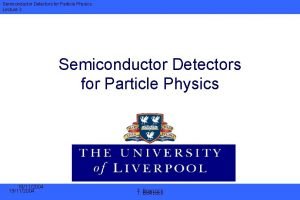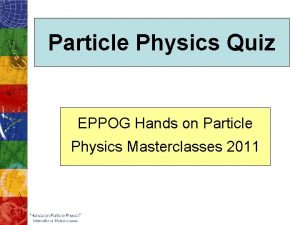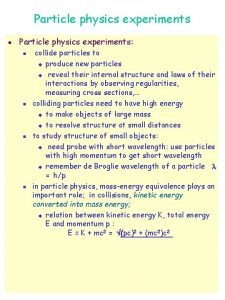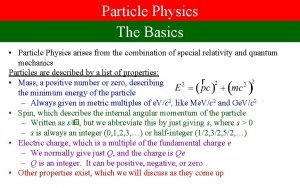Experimental Particle Physics Particle Interactions and Detectors Lecture































- Slides: 31

Experimental Particle Physics Particle Interactions and Detectors Lecture 2 21 st April 2008 Fergus Wilson, RAL 1

How do we detect Particles? n Particle Types q q q Charged (e-/K-/π-) Photons (γ) Electromagnetic (e-) Hadronic (K-/π-/μ-) Muonic (μ-) Gravitons ! n Interaction with matter q q q q Ionisation Loss Radiation Loss Photon Absorption Electromagnetic Showers Hadronic Showers Cherenkov Radiation Transition Radiation In general, we measure the energy lost as the particle passes through a medium. 21 st April 2008 Fergus Wilson, RAL 2

Transverse slice through CMS detector Click on a particle type to visualise that particle in CMS Press “escape” to exit 21 st April 2008 Fergus Wilson, RAL 3

21 st April 2008 Fergus Wilson, RAL 4

Which particles interact with which (caveat: some particles leave a small signal in a subdetector e. g. muon in subdetector? EM calorimeter) Detector Electron Charged Hadron (K+/π+) Muon Tracking Yes Yes Cherenkov Yes EM Calorimeter Yes Muon Detector 21 st April 2008 Photon Yes Transition Radiation Hadronic Calorimeter Neutral Hadron (π0) Yes Yes Yes Fergus Wilson, RAL 5

Charged Particle Detectors n Physics q q q Ionisation Mean Energy Loss Fluctuations Cherenkov Light Transition Radiation 21 st April 2008 Detectors n Emulsion 2. Bubble Chambers 3. Scintillation Detectors 4. Wire Chambers 5. Multi Wire Proportional Chambers (MWPC) 6. Geiger Muller 7. Solid State Devices 8. Time Projection (TPC) 9. Resistive Plate Counters (RPC) 10. Limited Streamer Tubes (LST) 11. Cherenkov 12. Transition Radiation Fergus Wilson, RAL(TRD) 1. 6

Ionisation and Atomic Excitation n n Heavy Charged particles interact with electrons in material as they pass Can be calculated: The Bethe-Bloch Equation Ok for energies between 6 Me. V and 6 Ge. V Maximum energy loss Function only of β (approximately) in single collision Constant Stopping Power 21 st April 2008 1/2 Ionisation Constant for material Fergus Wilson, RAL Density correction 7

Stopping Power 1/β 2 21 st April 2008 Ionisation Constant ln(β 2) Fergus Wilson, RAL 8

Mean Energy Loss in different materials High energy ~ ln Low energy ~ 1/β 2 Minimum at 3 21 st April 2008 Fergus Wilson, RAL Distance units: Ø g cm-2 9

Energy Fluctuations n n n Bethe-Block only gives mean, not most probable Large high energy tail – δ rays Landau distribution: δ-rays : electrons produced by the Bethe. Block equation that have sufficient energy to ionize further atoms through subsequent interactions on their own. 21 st April 2008 Fergus Wilson, RAL 10

Particle Identification by Energy Loss (d. E/dx) K μ p e Results from a Time Projection Chamber Results from a Drift Chamber (PEP 4/9) (Ba. Bar) 21 st April 2008 Fergus Wilson, RAL 11

Ionisation Detectors Ionisation used to detect particles in different ways: 1. Observe physical or chemical change due to ions 2. Detect energy from recombination - scintillation 3. Collect and measure free charges - electronic 21 st April 2008 Fergus Wilson, RAL 12

Emulsions n n Expose film to particles and develop Natural radioactivity was discovered this way Still occasionally used for very high precision, low rate experiments Similar technique in etched plastics CHORUS (neutrinos) 800 kg of emulsion 4 stacks of 8 modules each 35 x 70 x 2. 9 cm 3 21 st April 2008 Fergus Wilson, RAL 13

Bubble Chambers (1960 s-1970 s) BEBC n n n Ionisation trail nucleates bubbles in superheated liquid Liquid H 2 (or similar) close to boiling point Suddenly reduce pressure. Fire beam into chamber Take photo Cloud chamber similar: ions nucleate condensation in saturated vapour 21 st April 2008 Fergus Wilson, RAL 14

Scintillation Detectors Detect photons from electronic recombination of ions n Organic (plastic) n Inorganic (crystal or glass) q doping normally required n n n 21 st April 2008 Not very efficient ~1 photon/100 e. V Light carried to sensitive photodetectors Fast, cheap and flexible Fergus Wilson, RAL 15

Wire Chambers n n Free electrons will be attracted to anode Electric field near thin wire increases Secondary ionisation may start to occur q avalanche! A typical gas detector will have ~20 primary ions per cm created by a track. 21 st April 2008 Fergus Wilson, RAL e- +V e- ee- 16

Gas Amplification Proportional Chambers Maximum gain ~107 Avalanche fills volume Arcing Full charge collection 21 st April 2008 l Geiger Muller Tube l Resistive Plate Chambers Start of avalanche region Fergus Wilson, RAL 17

Geiger Region n Geiger Counter Spark Chamber q short bias pulse->localise breakdown Streamer Chamber q Large volume, transparent electrodes 21 st April 2008 Fergus Wilson, RAL 18

MWPC n Need better idea for large volume coverage at high rates q Multi-Wire Proportional Chamber q Fast n q q q Ion Drift Velocity ~ 50 km/s (50 μm/ns) Resolution ~pitch/ 12 x from anode y from ions at segmented cathode plane 21 st April 2008 Fergus Wilson, RAL 19

Drift Chambers n n Electron drift speed depends on electric field and gas Time delay of hit gives distance from sense anode Extra wires can be used to separate drift and avalanche regions Typical values: q drift distance ~cm q drift velocity ~ 50 km/s (50 μm/ns) q drift time ~ s q precision ~100 μm 21 st April 2008 Fergus Wilson, RAL 20

Stereo Readout n n n Good z resolution Need readout along length Ghost hits 21 st April 2008 n n n Good pattern recognition Readout from ends Poor z resolution Fergus Wilson, RAL 21

Ba. Bar Drift Chamber Open Cell Drift Chamber n 2. 8 m long n Gas volume ~ 5. 6 m 3 n 7100 anode wires n Axial and stereo n ~50, 000 wires in total 21 st April 2008 Fergus Wilson, RAL 22

Time Projection Chamber Ingredients: Gas E. g. : Ar + 10 to 20 % CH 4 q E-field E ~ 100 to 200 V/cm q B-field as big as possible to measure momentum to limit electron diffusion q Wire chamber to detect projected tracks Timing gives z measurement q Long drift distances gas volume with E & B fields q B y E x z ~ metres 21 st April 2008 drift Fergus Wilson, RAL charged track wire chamber to detect projected tracks 23

Detector with TPC 21 st April 2008 Fergus Wilson, RAL 24

General considerations for Wire Chambers n n Gas, voltage and geometry must be chosen carefully. q precision, amplification, avalanche characteristics. . . q Chambers can be damaged. External magnetic field influences behaviour. q n n n Must be measured and understood. MWPC: q fast, reliable q often used for triggering Drift/TPC: q large volume, reasonably precise q high incident fluxes can cause “short circuit” q long readout time Need other solution for high rates and/or extreme precision 21 st April 2008 Fergus Wilson, RAL 25

Silicon Strip Detector n n n n Particle physics needs detectors which can determine the position of particles with an accuracy of 0. 01 mm, have minimal thickness (0. 3 mm), and have very fast ( 0. 000000025 second) time response. Silicon, a semiconductor, can be fabricated in two forms; n type, with a surplus of electron sites in the crystal lattice, and p type, with a deficit of electron sites in the crystal lattice. The majority of silicon detectors consist of n type bulk material. The back face has an aluminium contact over the complete surface. The front face has p type silicon strips implanted in the surface. These p type strips aluminium strips on their surface. The aluminium strips are separated from their associated p type silicon strips by a thin insulator. An electric field is applied between the p strips and the back face. When a charged particle passes through a silicon detector it creates ionisation in the bulk of the silicon. This frees electrons from the atoms of the silicon and leaving these atoms with an electron vacancy. These vacancies are referred to as "holes". The "holes" "drift" in the electric field towards the negatively charged p type strips. The electrons "drift" towards the positively charged back plane. When the "holes" reach the p type strip they are collected and induce a measurable charge on the associated aluminium strip. The aluminium strips are connected to sensitive electronic read out channels. By recording which electronic channel fired, it is possible to determine where the charged particle passed through the detector. 21 st April 2008 Fergus Wilson, RAL 26

Solid State Detectors n n n Detect ionisation charges in solids q high density → large d. E/dx signal q mechanically simple q can be very precise Semiconductors q small energy to create electronhole pairs q silicon extremely widely used n band gap 1. 1 e. V n massive expertise and capability in electronics industry Resistors q plastic – cheap q diamond – robust, rad. hard q Germanium – can be made thick 21 st April 2008 Implanted p-strips 50 -150 μm pitch Resolution = pitch/√ 12 Fergus Wilson, RAL +-+ 300 μm thick n-type silicon V ~22, 000 electron-hole pairs per MIP (most probable) in 300μm 27

Reminder: p-n Junctions http: //britneyspears. ac/physics/pn/pnjunct. htm d Silicon doped to change electrical properties Charge carriers diffuse out of depletion region Net space charge electric field Intrinsic depletion can be increased by reverse bias 21 st April 2008 Fergus Wilson, RAL 28

Cerenkov Detector n Cerenkov Radiation q q q q A charged particle will radiate energy if its velocity is greater than the local phase velocity of light speed of light in medium = c/n n = refractive index charged particles produce light “shock waves” if v>c/n light cone cosθ = c/vn = 1/(nβ) “eerie blue glow” Useful for separating pions and kaons 21 st April 2008 Fergus Wilson, RAL LHCb 29

Transition Radiation Detector GLAST launches May 16 http: //www. nasa. gov/glast GLAST n n An energetic charged particle moving through matter momentarily polarizes the material nearby. If the particle crosses a boundary where the index of refraction changes, the change in polarization gives rise to the emission of electromagnetic transition radiation. About one photon is emitted for every 100 boundaries crossed. Transition radiation is emitted even if the velocity of the particle is less than the light velocity of a given wavelength, in contrast to Cerenkov radiation. Consequently, this radiation can take place in the x-ray region of the spectrum where there is no Cerenkov radiation, because the index of refraction is less than one. At each interface between materials, the probability of transition radiation increases with the relativistic gamma factor. Thus particles with large γ give off many photons, and small γ give off few. For a given energy, this allows a discrimination between a lighter particle (which has a high γ and therefore radiates) and a heavier particle (which has a low γ and radiates much less). Useful for separating pions and electrons 21 st April 2008 Fergus Wilson, RAL 30

Next Time. . . More interactions and detectors 21 st April 2008 Fergus Wilson, RAL 31
 Frontier detectors for frontier physics
Frontier detectors for frontier physics Experimental vs non experimental
Experimental vs non experimental Experimental vs non experimental
Experimental vs non experimental Disadvantages of experimental research
Disadvantages of experimental research Experimental vs non experimental
Experimental vs non experimental Nonexperimental study
Nonexperimental study Where are feature detectors located
Where are feature detectors located Feature detectors ap psychology
Feature detectors ap psychology Feature vectors
Feature vectors Feature detectors
Feature detectors Yodsawalai chodpathumwan
Yodsawalai chodpathumwan What is thermal detector
What is thermal detector Streaming current detectors
Streaming current detectors Vhv voltage detectors
Vhv voltage detectors Photo detectors
Photo detectors Nuclear detectors
Nuclear detectors Chromatography mobile phase and stationary phase
Chromatography mobile phase and stationary phase Giant wave detectors murmurs universe
Giant wave detectors murmurs universe Wave could hear murmurs across universe
Wave could hear murmurs across universe Experimental physics and industrial control system
Experimental physics and industrial control system Experimental physics and industrial control system
Experimental physics and industrial control system Experimental physics and industrial control system
Experimental physics and industrial control system 01:640:244 lecture notes - lecture 15: plat, idah, farad
01:640:244 lecture notes - lecture 15: plat, idah, farad Interactions between ais and internal and external parties
Interactions between ais and internal and external parties Classical mechanics
Classical mechanics Physics 101 lecture
Physics 101 lecture Phy101 lecture 1
Phy101 lecture 1 Physics 101 lecture notes pdf
Physics 101 lecture notes pdf Waves physics pdf notes
Waves physics pdf notes Atmospheric physics lecture notes
Atmospheric physics lecture notes Pmt particle physics
Pmt particle physics Modern particle physics mark thomson
Modern particle physics mark thomson
